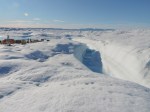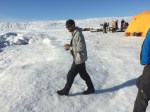Posted by Pat Ryan, Graduate Student (Thursday, August 13, 2015)
It’s been a busy week. The events that transpired during and since the initial installation of the weather station on Petermann Glacier gave us some ups and some downs (therein the roller coaster). I’ve shared below (in italics) some of the emails that document the saga as it unfolded.
On Monday morning, we heard from Andreas:
I just got back after 12 hours working on Petermann Gletscher where I was given a helicopter for the day to accomplish the following:
1. Deploy very fancy sub-centimeter GPS receivers we got from UNAVCO (Peter of UDel);
2. Find a suitable site to place the Udel weather station with their 5 ocean sensors attached (Keith Nicholls of BAS);
3. Deploy the Udel weather station prior to the ice shelf drilling (I did this).
Less glamorous, I spent most of the day in packing and moving boxes while two helicopters were buzzing overhead coming and going as the first drill site was moved to a second drill site. At the end of the day, however, our weather station went up. It was not a pretty job as we had only an hour left before we had to be back on the ship, but the weather station is now sited and returns data on a regular schedule. It does work.
Here is a picture that shows the station’s current installation at site-3 which is temporary as Andreas will modify the mounting design after 5 ocean sensors are attached to it early next week. The shown design would not survive strong winter winds and excessive surface melting in the summer.
On Tuesday, our spirits were somewhat crushed when Andreas informed us that he had heard nothing from the station for 5 hours. As it was scheduled to automatically send data on an hourly basis, this was somewhat disappointing. Both Andreas (from the ship) and I (at home) attempted to manually connect to the station. Neither of us was successful. We all waited somewhat impatiently to hear from the station. Andreas was hopeful that he could get back to the site in order to diagnose and repair any problems that had arisen.
This morning (Thursday) I woke up to the following delightful email from Andreas. The subject line is Greeland Weather Station Working!!!
Hi all:
I am ecstatic to report that our weather station on Petermann Gletscher is alive collecting and reporting data. The earlier shut-down, 8-hours after deployment on Aug.-10, was caused by Iridium satellite transmissions, not the set-up of hardware or software of the weather station itself. I attach a plot of the data collected so far that is being used by the ship’s operators to prepare and plan for flight operations over the glacier. There will be a massive increase in helicopter flying, because on Saturday the CBS 60-Minute team will arrive via helicopter from Qaanaaq, Greenland about 250 miles to the south.
The five ocean sensors are NOT yet plugged into the UDel observing system, because ice-drilling operations at that site will not start until Monday or Tuesday. Our graduate student Peter Washam is on the glacier right now. The so-called Ice-Shelf team just completed a second drill hole near the grounding line of Petermann Gletscher where ice and water are expected to be as thick as the Empire State Building is tall. The picture shows Peter at that (second) drill site shortly after the camp there was established there Monday. The weather station was set-up about 13 km seaward at what will become the third drill site. Hopefully he did not forget to re-program the ocean sensors to move bits and bytes along the 600 m long serial cable (4800 baud) at a slower rate than we used them in an calibration test lowering them from the ship to the 600 m deep bottom of the ocean near Petermann Fjord.
- Drill Site-2 near the grounding zone of Petermann Gletscher. A small meltwater canyon on the right discharges into a lake behind the camp. The hot water drilling winch is visible on the upper left.
- Graduate student, Peter Washam at Drill Site-2
The 2 1/2 day long time series (link above) shows air temperature about 0.5 and 2.0 m above the ice as well as wind speed and direction as well as atmospheric pressure. A GPS unit shows that the station is drifting about 3 m per day towards the ocean as is expected for this fast moving glacier moving about 1.2 km per year.
My spirits are high after several days of anxious anticipation and waiting for a call from the weather station. Wish us luck.
Andreas (aboard I/B Oden at 81 32.28′ N 062 04.0′ W on 09:49 UTC)
Since the iridium system is designed to gather data until it can be successfully transmitted, short periods of communication black-outs are not expected to be a problem. The data storage is limited, so we are hopeful that the communication failure was temporary and any future lapses will be equally short-lived.
We soon should have have ocean data of salinity and temperature conditions under the glacier when the additional instruments have been lowered through the ice next week. That will be the story of our next post.






Hallo Andreas , alles toll. Wtr wuenschen Dir viel Erfolg .Mutti und Vati ..loth
Pat, thanks for posting the initial AWS data. Is incoming new data available somewhere on the web as a cvs file? I am curious about the lurches in position that worked out to 1200 meters per year on average — is not this GPS unit supposed to be super precise?
Not yet … but stay tuned. Regarding the precision of the GPS. There are two kinds of GPS devices being deployed. One is on the weather station. This is a standard GPS and that has measured the data referenced in this posting.
The very precise GPS is a different set of units. I’m not certain when those are scheduled to be installed. I will try to get that information for you, as well as any access information for the data as it is posted.